- 11. Sep. 2014 | 19.00
- 14. Sep. 2014 | 18.30
- 18. Sep. 2014 | 18.30
|
||||||
Bravo Cura
Celebrating José Cura--Singer, Conductor, Director
Operas: Fanciulla
Fanciulla in
Vienna 2014
José Cura as Dick Johnson--one of his best roles--in La Fanciulla del west at the Vienna state opera, September 2014
- Nina Stemme | Minnie
- Tomasz Konieczny | Sheriff Jack Rance
- José Cura | Dick Johnson (Ramerrez)
- 11. Sep. 2014 | 19.00
- 14. Sep. 2014 | 18.30
- 18. Sep. 2014 | 18.30
|
|
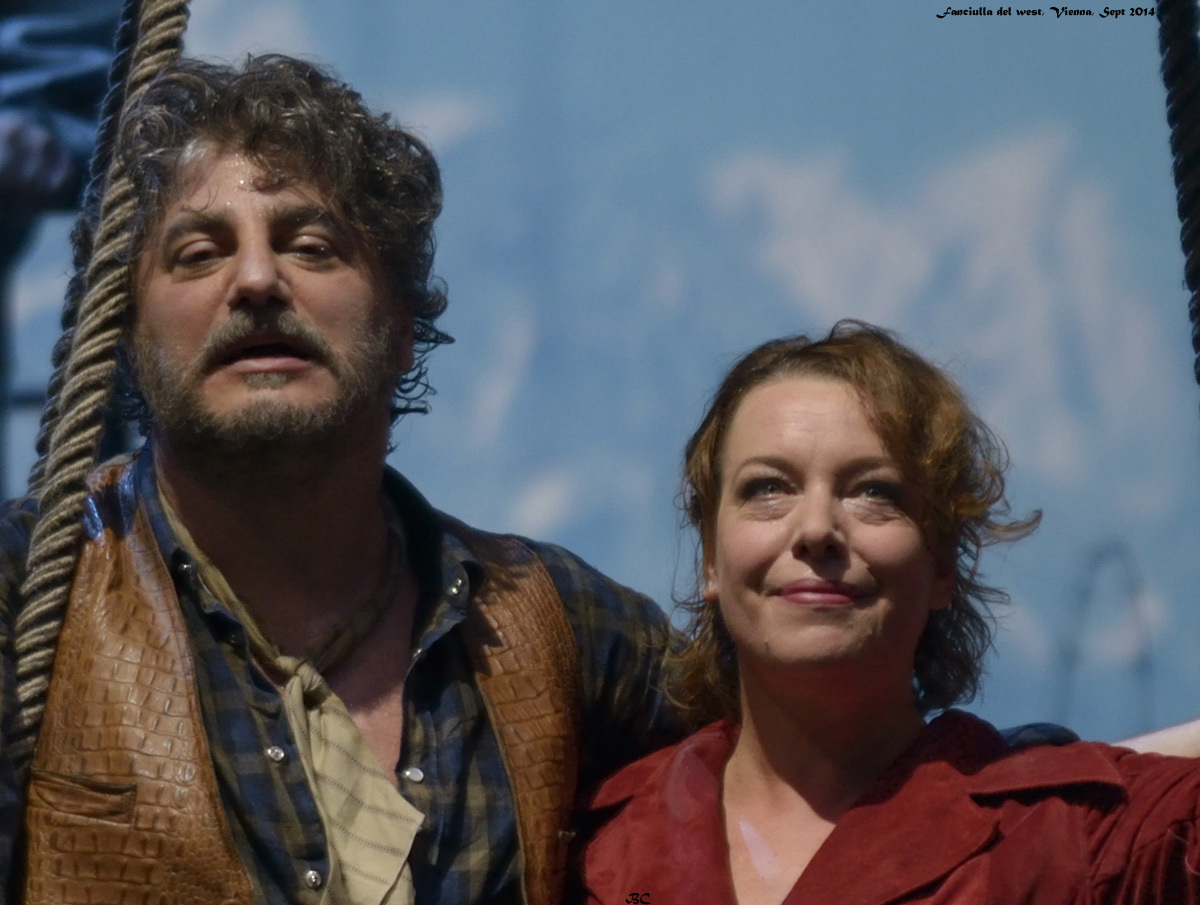
Eyewitness Reviews
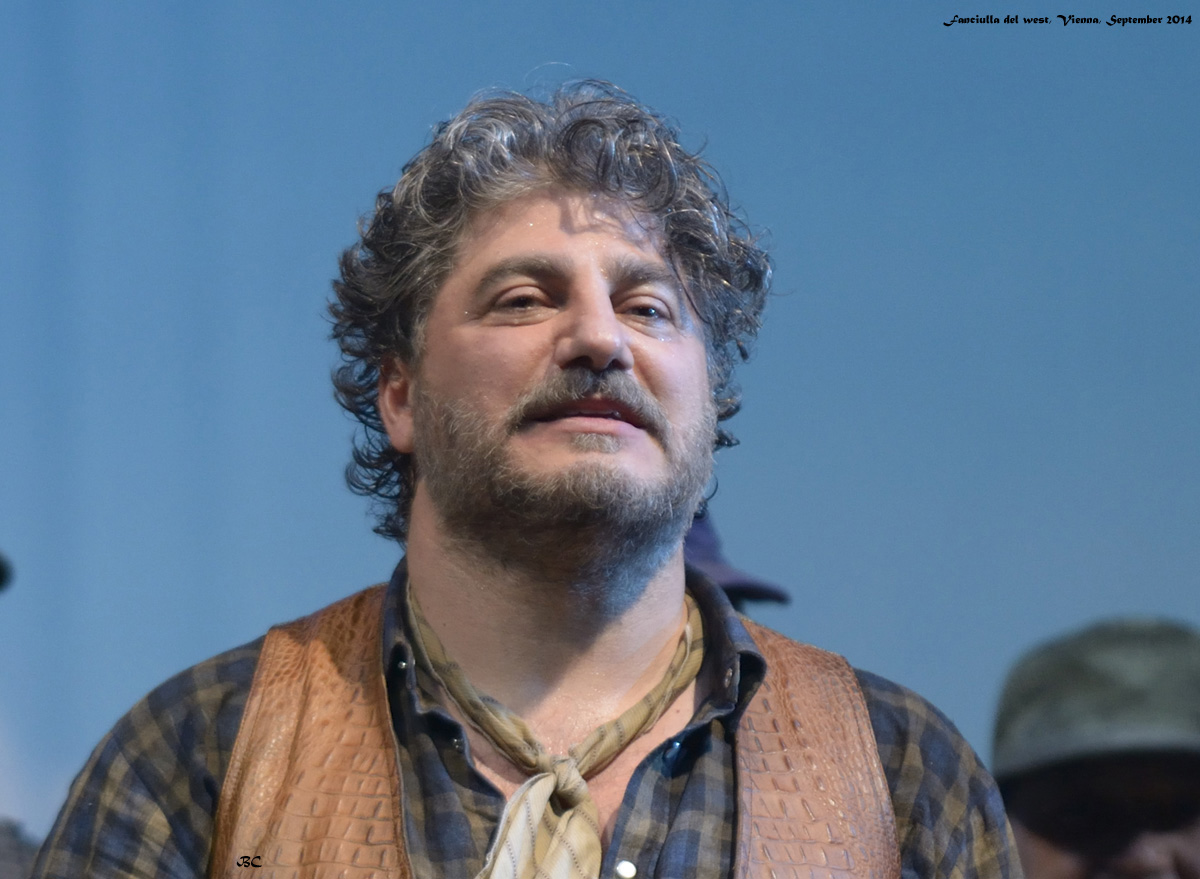
Bravo Cura
José Cura as Dick Johnson
José Cura continues to grow and develop his characters; even with Dick Johnson, perhaps the most perfect and comfortable fit of any of his roles, Cura is still innovating and imagining, improving and maturing. In this performance, he provided a most complex yet cohesive portrayal: Ramerrez is his heritage, the bandito his birthright, Nina his reward, but Johnson is who he is, the man who would be a scholar, a poet, a committed lover. This dichotomy of a man trapped between two worlds, struggling between right and wrong, family demands and independence, obligation and freedom, is what Cura captured so admirably in Vienna.
His understanding of the role was apparent from the subtleties, the shades, the nuances in his singing--his vocals were gloriously controlled and expressive--and in the half-smiles, the hopeful touches, the empty stares, the self-loathing: this is what sung drama is about, this merger of voice and psychology, this heightened emotional awareness of the human condition. Cura made us believe that this man would welcome death rather than continue to live torn between two worlds.
The two tenor arias were brilliantly and convincingly rendered but it was in the quieter passages, when the unwilling bandit measured the distance between reality and dream, that Cura shattered our hearts.
This would be an ideal opera for director Cura to consider undertaking: the tenor role, while intense and requiring some extreme vocal juggling, is well paced, with Johnson appearing only at the end of Act I, being incapacitated for much of Act II, and being primarily a silent actor in the last half of Act III. Please, some forward thinking opera theater, offer him the chance the showcase his vision of this wonderful and underrated Puccini opera!
Nina Stemme as Minnie
This Minnie had all the notes and then some, easily providing the vocal evidence of why she is such an outstanding Wagnerian. Unfortunately style and technique between the German and Italian schools are not interchangeable and loudness is not the only a prerequisite for this character. Otherwise, Stemme offered a committed performance and her acting, inconsistent and seemingly forced in the early scenes, improved considerably with the arrival of Dick Johnson.
Tomasz Konieczny as Rance
Another good singer who doesn't appear to 'do' Italian, Tomasz Konieczny is a big-voiced bass-baritone who--for me--failed to create a coherent, believable character. Suspicious, angry, violent, even arrogant, Konjeczny's Rance was an asocial bully who lacked the introspection that would lend credibility to his final act (a thwarted attempt to kill himself). In his faux leather black pants and bedazzled shirt, he was more sociopath than psychopath but never fully human, definitely never likable, and totally unsympathetic.
Staging (Marco Arturo Marelli)
Moving Fanciulla to the middle of the 20th Century is always problematic: there was no gold rush, indeed, no real rush for any metal, during the period, California was already densely populated and would have made the severe isolation that is so essential to the opera impossible, transportation was readily available, women would probably have been plentiful, and groups of men in general didn't go around lynching folks. The saloon was turned into something of a traveling cantina situated in the middle of stacked rail cars that served as homes, making the idea of being a secure repository for the 'gold' the men were digging somewhat ludicrous: just back up a car and wheel it away. Inconsistencies abounded: the camp itself was surrounded by barbed wire and it appeared that the men had regular jobs in which they trooped off together to the mines and then returned as a tribe: there was no lonesome miner spending weeks on his own in the wilderness; Johnson arrived with saddlebags; Minnie, who vows to defend the gold with her life, simply closes up and leaves the cantina unprotected at the end of Act I. There was electricity--in a major misstep, the 'camp singer' was a song from a boom box radio which was turned on for one number but never again turned on, even with the suggestion of dancing--but there were no phones, commonplace even in the mid-50s and earlier.
Act III was set in a train yard, though the reason is unclear: why would a group of men from a gold mine, ineffectually brandishing rifles and waiting for news about the capture of Johnson, head to a congested train lot? And the idea that Dick Johnson would be hanged by the men of the camp pushing a railroad car that weighed several tons out from under his feet was bizarre and unrealistic--though no more bizarre than the deus ex machina of the magic balloon that whisks Minnie and Dick away from California (the brilliant blue sky was, however, a welcomed change to the otherwise somber lighting).
The implication throughout was an unfounded indictment of the USA, with the director (apparently) under the impression North Americans still dress as cowboys and Indians, have never implemented the rule or law, and still have gold mines--run by corrupt corporate raiders who indulge in slave labor. The existential crisis that underlines Puccini's work was replaced with an ill-considered effort to be more current but without purpose.
Costumes (Dagmar Niefind)
Minnie was dressed so unflatteringly that it seemed maliciously intended. If in a more generous state of mind, there might be a strained progression from asexual tomboy/woman in a horrible jeans romper to the wannabe Nina Micheltorena dressed partially in red in the second act to the finale where Minnie arrives as a fully transformed woman who has moved beyond her first kiss, draped in red.
At least she got to change clothes between acts. Although the story takes place over a series of weeks (or months), the men are trapped inside the same garments. Rance was dressed without imagination in an ill-fitting black-on-black ensemble--don't villains always wear black? And poor Dick Johnson, the gentleman from Sacramento (and Spain), was forced to wear the same outfit, the one that should have been replaced once the bullet ripped through the shirt, from first entrance to final exit--even though it is unlikely that a man of taste and character would have styled himself in such a haphazard fashion.
Conducting (Graeme Jenkins)
The orchestra was too loud, played without nuance or sensitivity, and seemed happy to be doing their own thing while Maestro Jenkins kept beat. It was a disheartening experience. We were told that members of the orchestra change constantly so that rehearsals (if they happen) are meaningless; as a result, the purpose of the conductor seems really to just attempt to keep some time unison between what is happening in the pit and what is happening on the stage. But when you have a tenor who has the power to blow the leaves off trees at a hundred paces and a soprano who can pierce eardrums and the orchestra still drowns them out with regularity, there is something fundamentally wrong with the way music is being made in the Vienna Opera House.
Overall
Any time we can experience José Cura in Fanciulla the evening is a success. We've seen worse productions (Berlin comes to mind) and we've seen better productions (Covent Garden) but the constant has always been Puccini's sublime music and José Cura's ability to lift any production--and director's conceit--to the highest level. One shouldn't have to ignore the staging or overlook the logical inconsistencies--even in an illogical art form, there can be structure and purpose--but focusing on Johnson's slow realization that salvation might be possible only through death is mesmerizing. What some directors, like Marelli, seem to forget is that the staging itself is a character. If you don't get it right, then the entire ensemble is kept off-balance and you end up with the laugh-inducing final scene, as Dick and Minnie float skyward in a hot air balloon, the sky suddenly a brilliant blue as all the wrongs in the world become right.
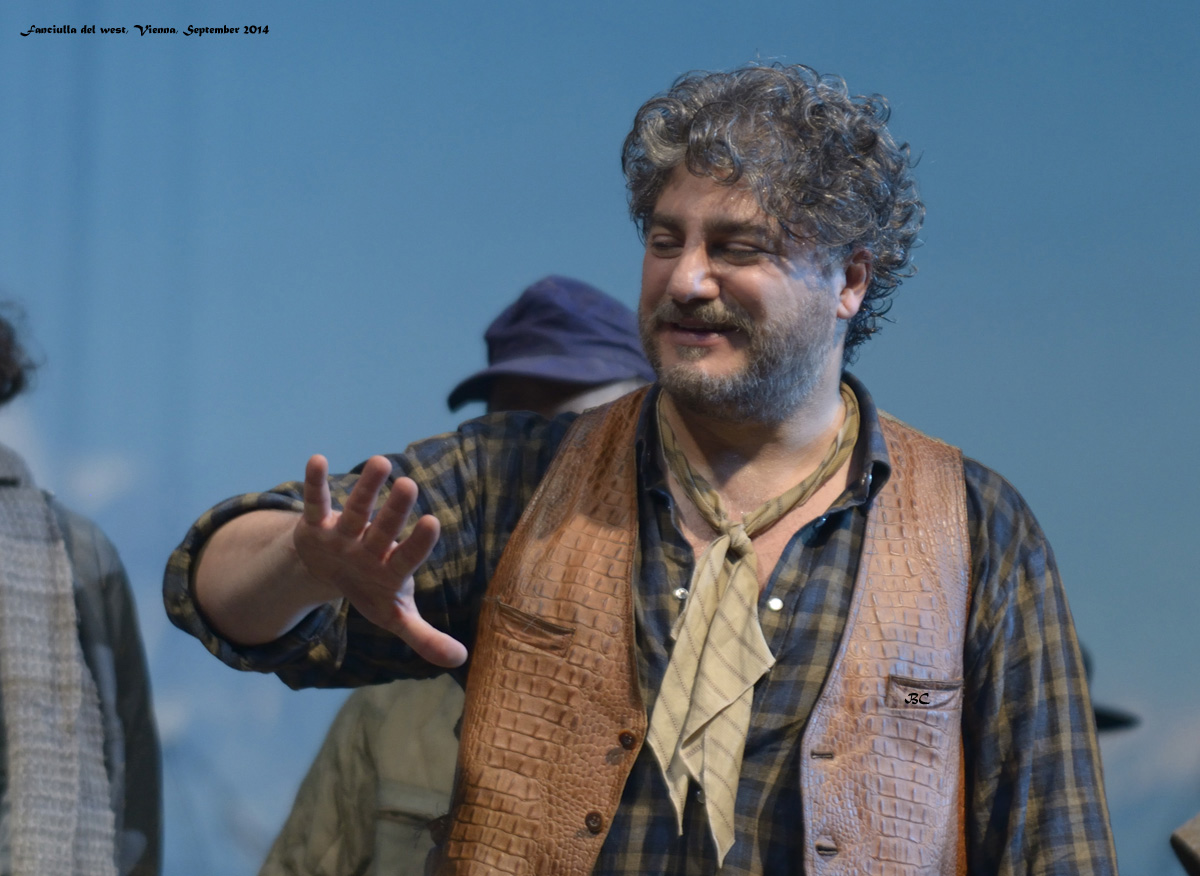
Eva and Herbert
Dear Kira and Deb!
We loved the performance with José Cura last sunday so much, that we bought also tickets for the next entrance! Althoug we have seen him as Johnson in Zürich, Berlin and London - this was the very best acting and singing with him in the title role. And we don't say this, because it is "our" Wiener Staatsoper!
Needless to say, we appreciated also Ninna Stemme and Tomasz Konieczny and watched with bated breath the gorgeous first dance, the first kiss and the wonderful end of every act! It is possible to achieve such an evening, when all together (as the conductor Graeme Jenkins) harmonize and give their best. Chance would be a fine thing, he would be more often in Vienna - but now we are a little bit consoled!
We did not see you, but we hope, you liked the atmosphere and the whole show as we did!
Hugz
Eva and Herbert
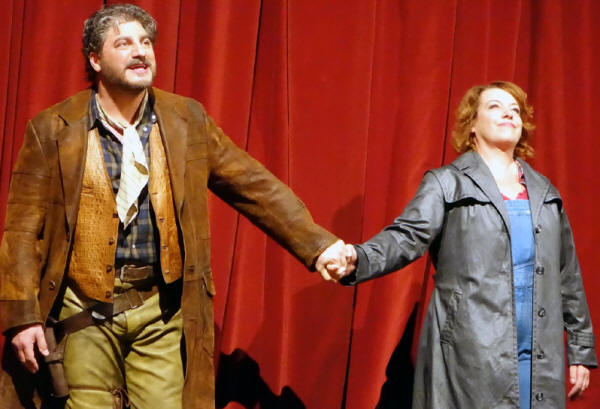 |
|
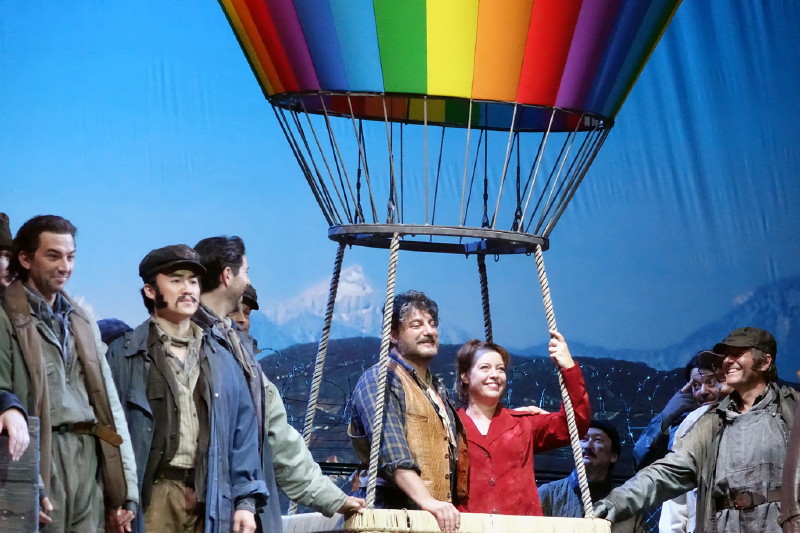 |
 |
Anja
For the last time, I had a chance to experience José Cura in my favourite opera house in terms of architecture (and my favourite opera of his repertoire). The beauty and complexity of the Vienna State Opera impress me each and every time.
In my opinion, the character of Dick Johnson and the whole opera seem to be written exclusively for José Cura, for his commanding, dark voice as well as for his acting. Although the singers were often “covered” by the orchestra, it was the first time I was really impressed by a Vienna production and the first time I wept in this house. The innovative staging by Marco Arturo Marelli is mostly well thought out (apart from a few flaws which could be easily fixed, for example the glance into Minnie’s wardrobe). It’s shifted to the middle of 20th century, which means no gold rush, no enthusiasm to explore something new, no hope for a better life any longer. Instead, the dreariness of hard work, being lost in nowhere, displacing their desires or wishes for love, projecting everything on their lost homeland, on the lost parents – and on Minnie (Nina Stemme).
Jack Rance (Tomasz Konieczny) is no bad guy on duty; he is a tormented soul, making no secret of his inglorious past and his addiction to money and card-playing. A loser who is desperate enough to show openly his vulnerability and embitterment, also vocally. I was deeply impressed by his performance.
In contrast to Rance, Johnson is hard-nosed, concealing his vulnerability behind a mask of arrogance. He is busy hiding his “real face” and – what an irony – particularly by this effort he attracts Minnie. She adores him for his cunning, his self-confidence, his knowledge of human nature. But probably he didn’t expect that she is about to forgive him being a bandit; while she can’t cope with the fact of his affair with Nina. Maybe it is human nature that people, feeling hurt by each other, can not simply embrace and cry together. Only when one of them is going to die, then they remind themselves of their love.
In my opinion, the finale of Fanciulla is one of the saddest. In many operas 2 or 3 people die, sometimes someone is mourning, while everybody else just go on. But Fanciulla is the story of a whole society, lost in desperation. And the irony goes on – the only two persons who consider California as their homeland must leave the country, while those who are suffering of homesickness are forced to stay. They once came there to improve their situation. And for sure they did the right thing, following Minnie’s plea to spare Ramerrez’ (and her) life. But there is no “recompense”, no salvation or prospect for a better future in this world or in an afterlife. They must simply accept the loss of their ray of hope in the shape of Minnie.
The only positive character is Nick (Carlos Osuna), the true hero who managed to preserve humaneness in a world of madness and violence. I think the ending would be more believable if Minnie and Ramerrez went off on a railway wagon. But on the other hand, the colourful balloon descending from sky or heaven just emphasized the incredibility of the so called happy end. Rance is going to kill himself while the miners slowly sink into an abyss. “Addio.” A terribly pessimistic end.
|
|
|
|
Last Updated: Saturday, April 27, 2019 © Copyright: Kira